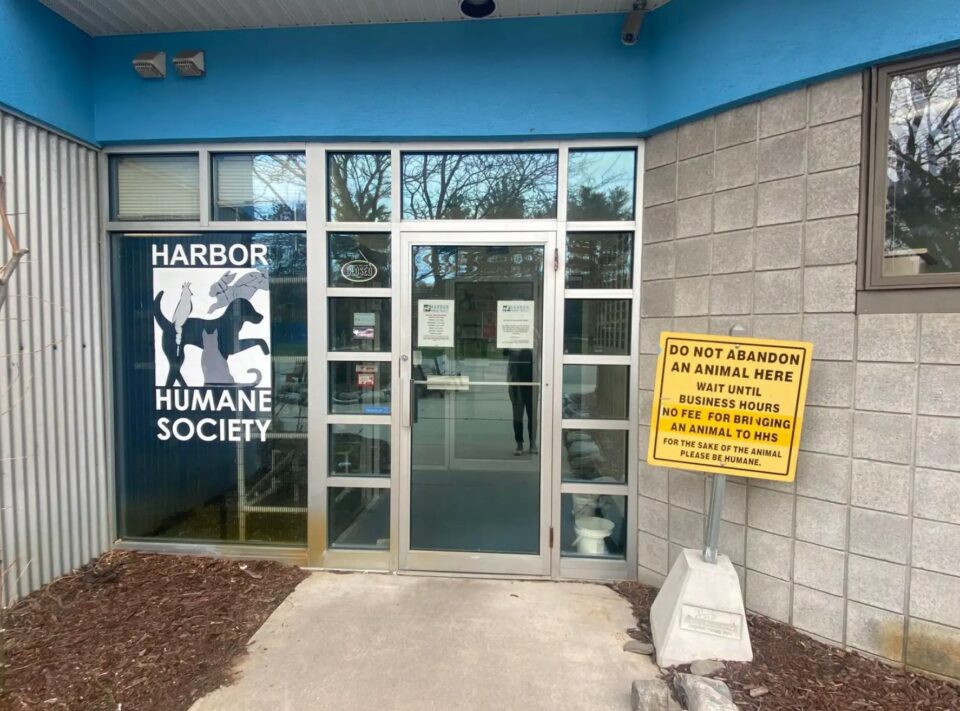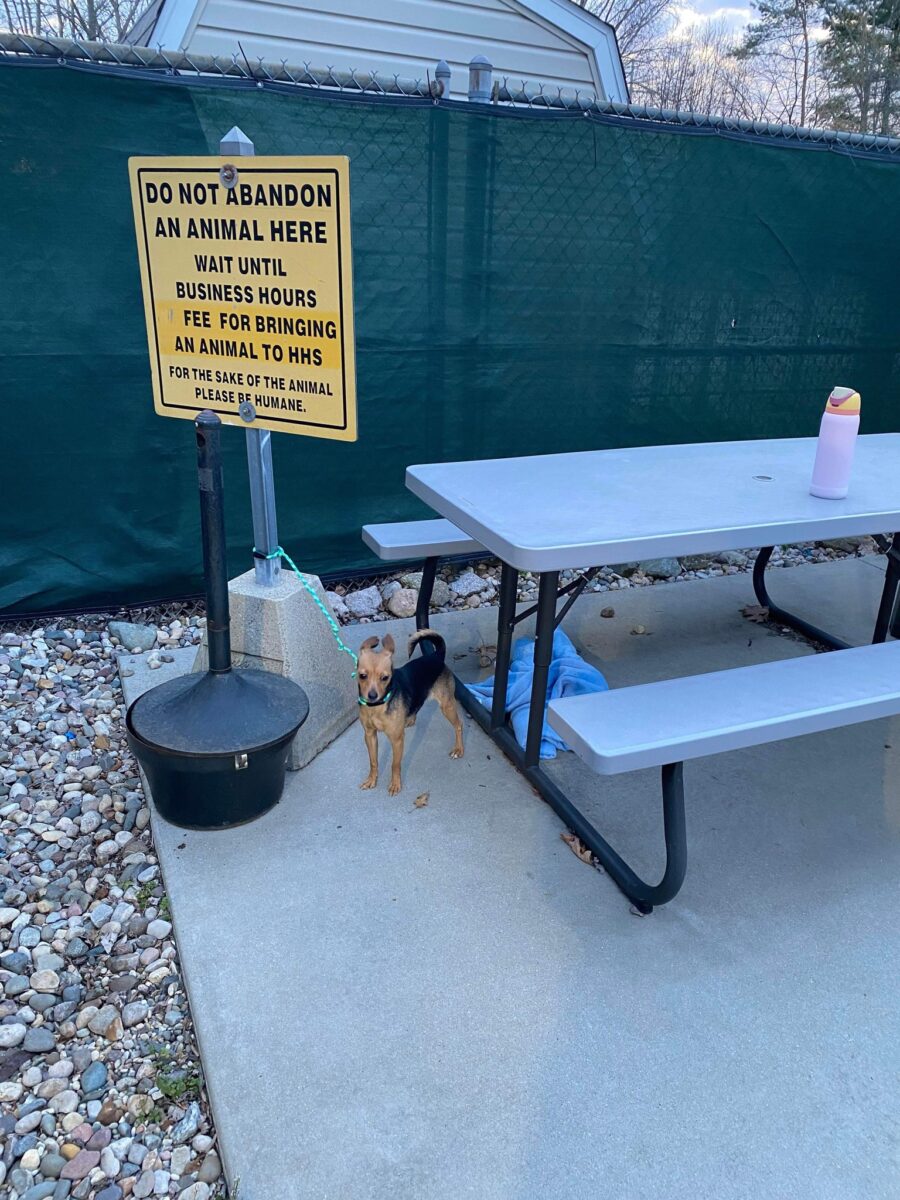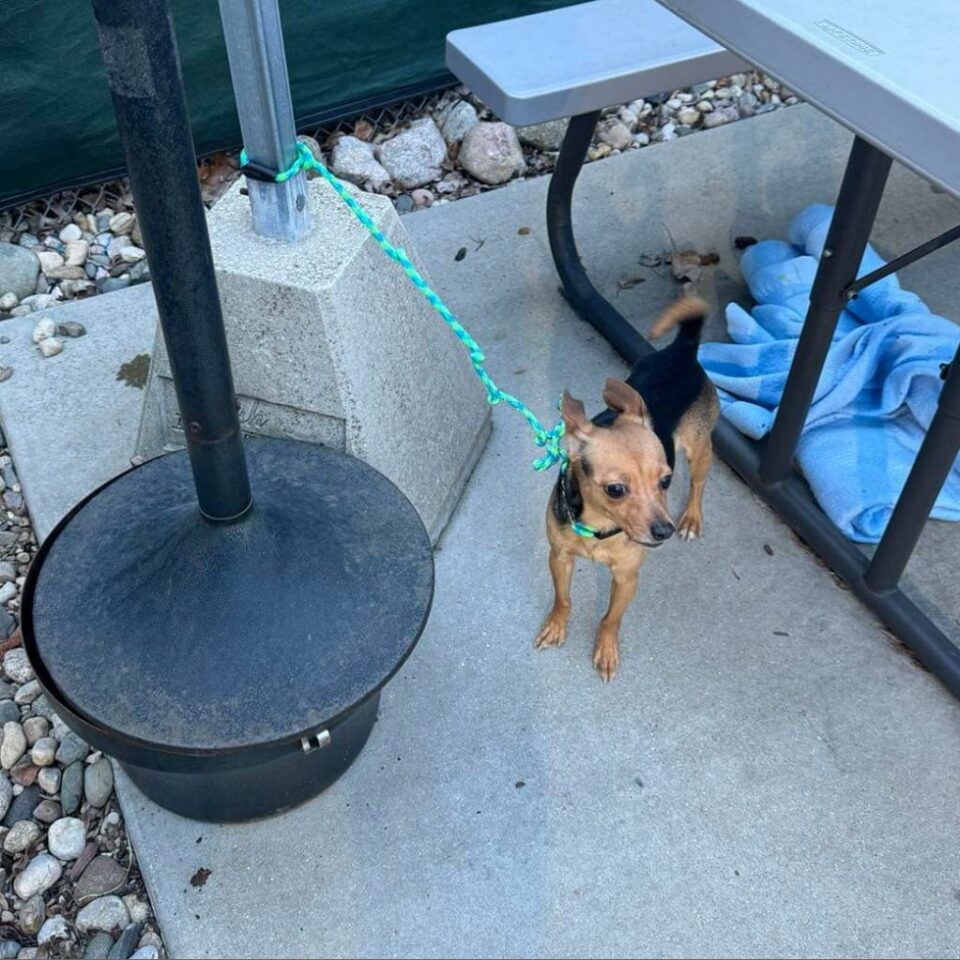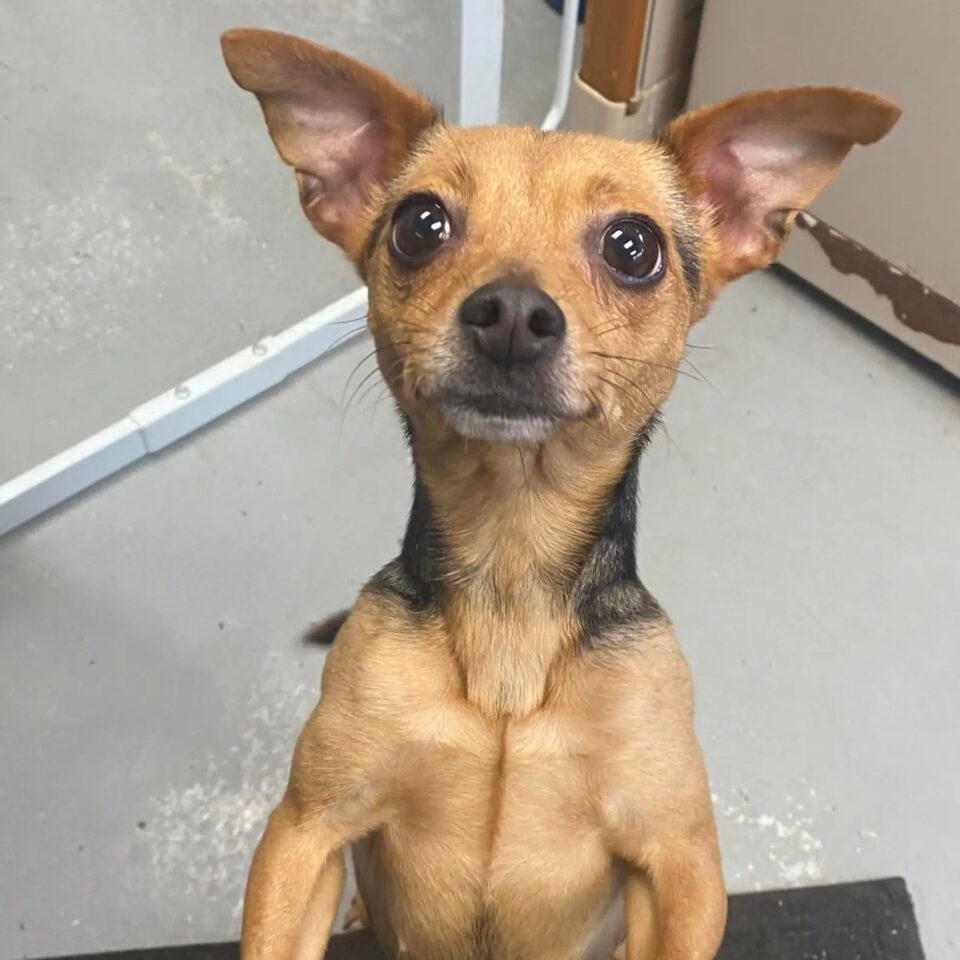Since the Harbor Humane Society, an animal shelter based in Michigan, had its fair share of animals dumped in front of their main entrance, they made sure to let people know that this was not okay.
They set a sign that clearly read that animal dumping was not allowed!
“Do not abandon an animal here. Wait until business hours. No fee for bringing an animal to HHS. For the sake of the animal, please be humane,” the sign reads.
Another one that had the same message on it was placed behind the shelter next to a picnic table where the staff would take their break.
Usually, these clear signs were respected… until one day.
Heartbreaking Find

When a worker came one morning to open the Michigan shelter, they didn’t notice anything unusual happening in the front of the shelter. However, the same could not be said for the back.
When they came out the back, they noticed a tiny pup tied to the base of the “do not abandon animals” sign. They suspected that the pup was abandoned the night before, and after checking the security cameras, their suspicions were confirmed.
The footage clearly showed that the dog, later named Trixie, was left at around 9 p.m. and wasn’t found until 7:30 a.m. the next morning. This means that she was sitting outside for 11 hours waiting to be rescued.

“Initially, she was nervous and scared, barking at her. But once she crouched down and gave her some time, she quickly warmed up and crawled right into her lap. She has been very friendly ever since!” Jen Nuernberg, director of marketing and strategic initiatives at Harbor Humane Society, told The Dodo.
Spending the whole night all alone did take a toll on Trixie as she kept on wondering why she was no longer with her hoomans.
But, when she met the new hoomans, all was well again. The rescuer immediately rushed her inside, where she warmed up and ate some delicious food.
As the other staff members arrived, they were completely heartbroken when they heard Trixie’s story.
They then ran some tests on this sweet girl, which, thankfully, proved that she was in good health – she was just a bit confused.

“When someone abandons an animal without any information, we are just left to guess. So we can assume she is about 3 to 4 years old, but we don’t know her story, her name, her likes, her favorite treats or toys. This is all information we try to get on animals when they are surrendered to the shelter,” Jen Self Aulgur, executive director at Harbor Humane Society, told The Dodo.
The Michigan shelter employees hope that Trixie’s previous owners will come forward to give some additional information about her before she is adopted, as this information will help them find the perfect home for her.
“This pup deserves to have her story and history known. We do not want to shame or get you in trouble — we just want to help this poor pup,” Self Aulgur said.

For now, Trixie is safe with the loving hoomans who make sure she has everything she needs. After some time passes, she will be available for adoption, but for now, she is enjoying her stay while receiving as many hugs and kisses as her little heart can desire.
Final Word
This story is the perfect example of why you should not abandon your pets.
While living with you, your pets get attached to you and their surroundings, and any sudden change can make them feel extremely anxious.
So, if you are not able to take care of your furry friends anymore, please do not abandon them like this. Take them to your local shelter, introduce them to the staff, and give them a second chance at life.
They deserve it!
If you’ve ever been greeted by your furry friend with a less-than-pleasant odor wafting from their mouth, you’re not alone. Doggy breath that could knock your socks off is a common concern among pet owners. As a seasoned dog enthusiast, you understand the importance of keeping your canine companion happy and healthy, and foul breath is often a sign that something may be amiss.
You’ve probably found yourself pondering the reasons behind your dog’s not-so-fresh breath. Whether it’s a case of stinky snacks, dental issues, or something more serious, understanding the root cause can help you address the issue and get your pup back to their playful, sweet-smelling self. So, let’s sniff out the reasons behind that funky breath and explore how you can help your furry friend feel minty fresh again.
Understanding Bad Dog Breath
The Causes of Halitosis in Dogs
Bad breath in dogs, or halitosis, can stem from various sources. One common cause is poor dental hygiene. When plaque and tartar build up on your dog’s teeth, it can lead to bacteria overgrowth, resulting in a foul odor. Other dental issues such as gum disease or oral infections can also contribute to bad breath. Additionally, your dog’s diet plays a significant role. Food particles left in the mouth can attract bacteria, leading to smelly breath. If your furry friend likes to scavenge for treats outdoors, they might ingest something unpleasant, causing bad breath.
Deciphering the Smell: What Different Odors Mean
The smell of your dog’s breath can provide clues about their health. A sweet or fruity odor could indicate diabetes, while a urine-like smell might point to kidney disease. If your dog’s breath smells like ammonia, it could be a sign of liver problems. A rotting smell may signal an infection in the mouth or gut issues. Understanding these different odors can help you identify potential health issues early on and seek appropriate veterinary care for your beloved pet.
Common Health Issues Related to Bad Breath
Dental Disease
Poor dental hygiene can lead to bad breath in dogs. Plaque buildup and gum disease are common culprits. Ignoring dental care can result in foul breath that signals potential dental issues. Regular teeth cleaning and check-ups are vital for your furry friend to maintain fresh breath and overall oral health.
Gastrointestinal Problems
Unpleasant breath can also indicate gastrointestinal problems in dogs. Issues such as indigestion, bloating, or even more severe conditions may be the cause. Monitoring your dog’s diet, ensuring they eat high-quality food, and seeking veterinary advice if their breath smells abnormal can help address underlying gastrointestinal issues.
Kidney Disease
Bad breath can be a sign of kidney disease in dogs. Kidney issues can lead to toxins building up in the body, causing a distinct and unpleasant odor in your dog’s breath. If you notice persistent bad breath along with other symptoms like increased thirst or frequent urination, it’s crucial to consult your vet for a proper diagnosis and treatment.
Liver Disease
Liver problems can also manifest as bad breath in dogs. A liver condition may impact the way your dog’s body metabolizes waste products, resulting in bad breath. If your dog’s breath has a fruity or sweet smell, it could be a sign of liver disease. Prompt veterinary attention is necessary to address any potential liver issues affecting your canine companion.
Diet and Its Impact on Your Dog’s Breath
Ingredients to Avoid
When it comes to your dog’s breath, certain ingredients can contribute to the problem. Scour the ingredient list of your dog’s food for additives like corn syrup, sugar, and artificial flavors, as these can worsen bad breath by promoting bacterial growth in the mouth. Avoiding these additives in your dog’s diet can help in keeping their breath fresher.
Best Foods for Freshening Breath
Opt for dog foods rich in natural ingredients such as parsley, mint, and dill. These herbs not only add flavor to the food but also contain natural properties that can freshen your dog’s breath. Additionally, crunchy fruits and vegetables like apples and carrots can help in cleaning your dog’s teeth and reducing plaque buildup, which in turn can improve their breath. Consider incorporating these fresh and natural foods into your dog’s diet to combat bad breath effectively.
Home Remedies and Preventative Measures
Regular Oral Hygiene Practices
To keep your dog’s breath fresh, it’s essential to maintain regular oral hygiene practices. Brushing your dog’s teeth a few times a week can help prevent plaque buildup and maintain overall oral health. Use a dog-friendly toothbrush and toothpaste to clean their teeth effectively. Additionally, providing dental chews or toys can help reduce tartar and keep their breath smelling better.
Natural Remedies for Improving Breath
In addition to regular brushing, you can try natural remedies to improve your dog’s breath. Incorporating fresh herbs like parsley or mint into their diet can help combat bad breath. These herbs contain natural deodorizing properties that can freshen your dog’s breath. Moreover, crunchy fruits and vegetables like apples and carrots can help clean your dog’s teeth and freshen their breath. Be sure to consult your vet before introducing any new ingredients to your dog’s diet to ensure their safety and effectiveness.
When to Consult a Veterinarian
Warning Signs to Look Out For
If your dog’s bad breath persists despite efforts to improve it through dental care and dietary changes, it’s crucial to consult a veterinarian. Additionally, if you notice any of the following warning signs accompanying the bad breath, seeking professional help is advisable:
- Excessive drooling
- Changes in appetite
- Red or swollen gums
- Loose teeth
- Bleeding from the mouth
- Pawing at the mouth
- Unusual growths in the mouth area
- Signs of pain or discomfort when eating or yawning
Professional Treatment Options
When it comes to addressing persistent bad breath and underlying health issues in dogs, a veterinarian can offer various treatment options tailored to your furry companion’s specific needs. Professional treatment may include:
- Dental procedures to address advanced dental disease
- Antibiotics to treat oral infections
- Dietary changes to improve oral health
- Laboratory tests to diagnose underlying medical conditions
- Medications to manage systemic health issues causing bad breath
- Professional dental cleanings under general anesthesia
Remember, your veterinarian is the best resource to help identify the root cause of your dog’s bad breath and provide appropriate treatment to ensure your furry friend’s overall health and well-being.
Conclusion
So, there you have it – bad breath in dogs can be a sign of various health issues that shouldn’t be ignored. Remember to keep an eye out for any warning signs and consult your vet if needed. By maintaining good oral hygiene, watching their diet, and using natural remedies, you can help keep your furry friend’s breath fresh. Don’t forget to show them some love with regular dental care and healthy treats. Your pup will thank you with wagging tails and fresh puppy kisses!
Frequently Asked Questions
What is halitosis in dogs?
Halitosis in dogs refers to bad breath, which can indicate underlying health issues like diabetes, kidney disease, and infections.
What are the common health issues related to bad breath in dogs?
Common health issues related to bad breath in dogs include dental disease, gastrointestinal problems, kidney disease, and liver disease.
How can diet impact a dog’s breath?
Diet can impact a dog’s breath by avoiding ingredients like corn syrup, sugar, and artificial flavors. Instead, incorporating natural ingredients such as parsley, mint, and dill, as well as crunchy fruits and vegetables like apples and carrots, can help freshen a dog’s breath.
What are the recommended oral hygiene practices for dogs?
Recommended oral hygiene practices for dogs include brushing their teeth a few times a week with dog-friendly toothbrushes and toothpaste, providing dental chews or toys to reduce tartar buildup, and incorporating natural remedies like fresh herbs and crunchy fruits and vegetables.
When should you consult a veterinarian for your dog’s bad breath?
Consult a veterinarian if bad breath persists despite efforts, especially if warning signs like excessive drooling, changes in appetite, red or swollen gums, loose teeth, bleeding from the mouth, pawing at the mouth, unusual growths, or signs of pain or discomfort when eating are present.
[no_toc]

Hey there, I’m Janet Brooks, a dog-loving student from California. I’m all about helping pups in need, especially those without homes. Me and my awesome friends work together to give shelter and love to stray dogs. Oh, and I also write blogs about dogs to share helpful info.